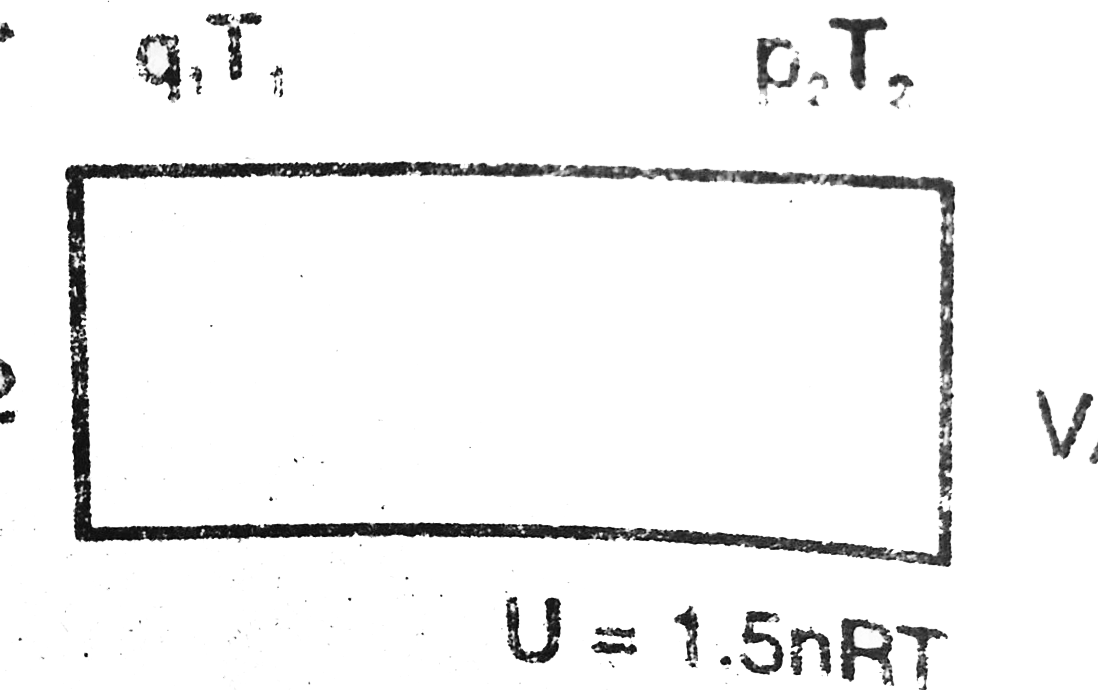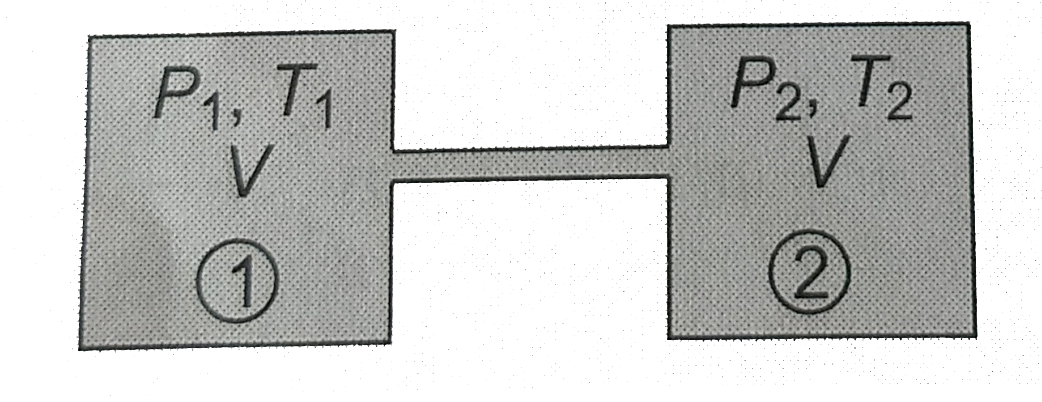shows a cylindrial tube of volume V with adiabatic walls containing an ideal gas. The internal energy of this ideal gas is given by 1.5nRT. The tube is divided into two equal parts by a fixed diathermic wall. Initially, the pressure and the tempreture are p1,T1 on the left and p2,T2 on the right. the system is left for sufficient time so that the tempreture becomes equal on the two sides. (a) how much work has been done by the gas on the left part ? (b) find the final pressures on the two sides. (c ) find the final equilibrium tempreture. (d) how much heat has flown from the gas on the right to the gas on the left ?

The correct Answer is:A, B, C, D
(a) Since the wall cannt be moved<br>thus, Delta U = 0<br>and Delta Q = 0<br>hence, Delta D = 0<br>(b)Let final pressure in LTS =p1tˆ∈RHS=p2<br>SinceN⊙ofmo≤srema∈sconstant.
Sop1V2RT1=p2V2RT
⇒p1=p1T1
= (p_1T_1T_2(P_1+P_2)/(T_1lambda) AsT=T2T1(P1+P2)λ
p1T2(P1+P2)λ
SimilarlyP_2 = (p_2T_2(P_1+P_2))/(lambda)<br>(c)LetT2>T1and'T'be the common temperature
Initialy P−2v)2=n2RT1
⇒n1=P1V2RT1
HenseΔQ=0,ΔW=0
HenseΔU=0
∈caseLHS,Delta U_1 = 1.5n_2R(T-T_2)<br>in case LHS<br> = Delta U _2 = 1.5n_2R(T_2-T)<br>But Delta U_1-Delta U_2 = 0<br>rArr 1.5n_1R(T-T_1) =1.5n_2R(T_2-T) <br>rArr n_1T-n_1T_1 = n_2T_2-n_2T<br>rArrT(n_1+n_2) =n_1T_2+n_2T_2<br>rArr T = ( n_1T_1+n_2T_2)/(n_1+n_2)<br> = (P_1VxxT_1)/(2RT_1)+(P_2VxxT_2)/((2RT_2)/(P_1V)/(2RT_1)+(P_2V)/(2RT_1)<br> = ((P_1+P_2)T_1T_2)/(lambda)<br>as P_1T_2+P_2 = T_1lambda<br>(b)For RHS<br> Delta Q = Delta U = (asDelta W = 0)<br>1.5 n_2R(T_(2 )-T)<br> = (1.5 P_(2)V)/(2RT_(2)) R [T_(2) -((P_(1)+P_(2))T_(1)T_(2))/(P_(1)T_(2)+P_2T_(1))]<br> = (1.5P_(2)V)/(2RT_(2))xx(P_(1)T_(2)^2-P_(1)T_(1)T_(2))/(lambda)<br> = (1.5 P_(2) V)/(2RT_(2)) xx (T_(2) -P_(1) (T_(2)-T_(1)) / (lambda)<br> =(3P_(2)P_(1)V(T_(2)-T_(1)))/(4lambda)

Topper's Solved these Questions
- LAWS OF THERMODYNAMICSBook:HC VERMAChapter:LAWS OF THERMODYNAMICSExercise:Short Answer
Explore 15 Videos
- LAWS OF THERMODYNAMICSBook:HC VERMAChapter:LAWS OF THERMODYNAMICSExercise:Objective 2
Explore 5 Videos
- KINETIC THEORY OF GASESBook:HC VERMAChapter:KINETIC THEORY OF GASESExercise:Exercises
Explore 62 Videos
- NEWTON'S LAWS OF MOTIONBook:HC VERMAChapter:NEWTON'S LAWS OF MOTIONExercise:Exercises
Explore 42 Videos
Similar Questions
An insulting container of volume 2V0 is divided in two equal parts by a diathermic (conducting) fixed piston. The left part contains one mole of monoatomic ideal gas whereas right part contains two moles of the same gas. Initial pressue on each side is P0. The system is left for sufficient time so that a steady state is reached. Find (a) the work done by the gas in the left part during the process, (b) initial temperature in the two sides, (c) the final common temperature reached by the gases, (d) the heat given to the gas in the right part and (e) the increase in the internal energy of the gas in the left part.
View SolutionAn adiabatic vessel of total volume V is divided into two equal parts by a conducting separtor. The is fixed in this position. The part on the left contains one mole of an ideal gas (U=1.5nRT) and the part on the right contains two moles of the same gas. initially, the pressure on each side is p. the system is left for sufficiant time so that a steady state is reached. find (a) the work done by the gas in the left part during the process, (b) the temperature on the two sides in the beginning, (c ) the final common temperature reached by the gases, (d) the heat given to the gas in the right part and (e) the increase in the internal energy of the gas in the left part.
View Solution
Knowledge Check
A cylindrical tube with adiabatic walls having volume 2V0contains an ideal monoatomic gas as shown in figure. The tube is divided into two equal parts by a fixed super conducting wall. Initially, the pressure and the temperature are P0,T0 on the left and 2P0,2T0 on the rigid. When system is left for sufficient amount of time the temperature on both sides becomes equal
 AFind work done by the gas on the right part?BFind the final pressure on the two sidesCFind the final equilibrium temperatureDHow much heat has flows from the gas on the right to the gas on the left?
AFind work done by the gas on the right part?BFind the final pressure on the two sidesCFind the final equilibrium temperatureDHow much heat has flows from the gas on the right to the gas on the left?A cylindrical vessel made of thermally insulating material is divided into two equal parts by an insulating and. Movable piston. Both parts contain ideal monoatomic gas . The gas in the left part is supplied heat such that the volume of right part becomes one-eight of its initial volume . Work done by the gas in the right part is
 A−92PVB92PVC−3PVD3PV
A−92PVB92PVC−3PVD3PVA container with insulating walls is divided into two equal parts by a partition fitted with a valve. One part is filled with an ideal gas at a pressure P and temperature T, whereas the other part is completely evacuated . If the valve is suddenly opened, the pressure and temperature of the gas will be
AP2,TBP2,T2CP, TDP,T2
Two vessels A and B with rigid walls containing ideal gases. The pressure, temperature and the volume are P1,T1,V in the vessel A and P2,T2,V in the vessel B. The vessels are now connected through a small tube. In equilibrium, pressure P and temerature T becomes same in two vessels. Find the value of P/T.

View SolutionShow a cylindrical tube of volume V_(0) divided in two parts by a frictionless separator. The walls of the tube are adiabatic but the separator is conducting, Ideal gases ate filled in the two parts. When the swparator is kept in the middle, the pressure are p_(1) and p-(2) in the left part and the right part respectively. The separator is slowly slid and is released at a position where it can stay in equilibrium. Find the volumes if the two parts. (figure)
View SolutionTwo thermally insulated vessels are filled with an ideal gas. The pressure, volume and temperature in the two vessels are P1,V1,T1 and P2,V2,T2 respectively. Now, the two vessels are connected using a short insulating tube.
(a) Find final temperature of the gas.
(b) Express the final pressure of the gas in terms of P1,V1,P2 and V2 only.
View SolutionShows a cylindrical tube with adiabatic walls and fittled with a diathermic separetor. The separetor can be slid in the tube by and external mechanism. An ideal gas is injected into the two sides at equal pressures and equal temperatures. The separetor remaons in equilibrium at the middle. It is mow slid to pisition where it devides the tube in the ratio of 1:3. Find the ratio of the pressures in the two parts of the vessel.

View SolutionIn given figure, an adiabatic cylindrical tube of volume 2V0 is divided in two equal parts by a frictionless adiabatic separator. An ideal gas in left side of a tube having pressure P1 and temperature T1 where as in the right side having pressure P2 and temperature T2.Cp/Cv=γ is the same for both the gases. The separator is slid slowly and is released at a position where it can stay in equilibrium. Find (a) the final volumes of the two parts (b) the heat given to the gas in the left part and (c) the final common pressure of the gases,

View Solution

